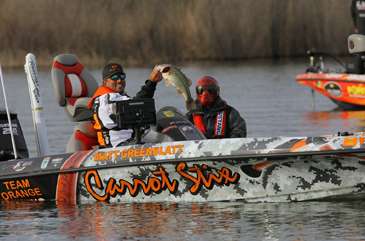
When bass are on beds, Matt Greenblatt has one surefire way to trick them into biting.
“One of the best ways to catch a fish off the bed is drop shotting,” says the Elite Series pro. “You can leave it in the bed a lot longer and upset that fish.
“If the fish is ready, and you fire that drop shot in there, you are money. You are going to catch that fish. If you are throwing something into the bed, such as pitching a beaver or a craw, and you are jiggling it, you are always moving it more or less forward. You can pitch that drop shot in there and let it sit for as long as you want. If you watch a bedding bass you know it’s protecting the bed, but it’s really protective of one area of that bed. So you can leave the drop shot in the fish’s sweet spot.”
The length of the drop line is the main difference between drop shotting in deep water or for bedding fish in the shallows. “The shorter the leash, the easier it is to (tick) off the fish,” says Greenblatt. The Florida pro usually sets his weight about 8 to 12 inches below the rig’s hook when fishing in deep open water, but he shortens his drop line to 3 or 4 inches for bed fishing.
His drop shot rig includes a Gamakatsu No. 1 circle hook for nose hooking small finesse baits such as a Yamamoto Shad Shape Worm and Berkley Gulp! Fry or a Gamakatsu 1/0 hook for Texposing longer finesse worms. He attaches a 3/4-ounce weight on his rig most of the time, but occasionally scales down to a 3/8- or 1/2-ounce weight for the calmest conditions.
“You want a heavy enough weight so that it stays in the bed while you’re moving the bait, but you’re moving it in place,” he says.
The bedding bass’ attitude dictates how Greenblatt presents his drop shot rig.
“You’re basically reading the fish’s reactions,” he says. “The fish are all different. Sometimes if you do a lot of shaking, it spooks the fish. If the fish isn’t locked on real tight, it will shy away from a lot of shaking. The majority of the time I’m shaking it pretty good because I want the fish to get upset that it’s there.”
The drop shot rig allows Greenblatt to keep his lure in front of the fish’s face the whole time, whereas a Texas rigged bait spends most of its time lying on the bottom below the fish. Greenblatt can also let his bait occasionally fall to the bottom and pop it back in front of the fish.
“A lot of times that snap from the bottom will make that fish go nuts because it’s something that catches its eye and makes it go into a defensive mode.”
The key to the presentation is to prevent moving the weight while shaking the lure, a tactic Greenblatt notices beginners have trouble accomplishing. He often sees novices moving the whole rod to shake their lure, which tends to move the sinker as well. Shaking only his rod tip a couple of inches at a time on slack line lets Greenblatt impart action to his lure while keeping the weight stationary in the bed.
When he sees a bedding fish eat his bait, Greenblatt sets the hook immediately.
“It’s not something that the fish is going to hold onto for long since the fish is not eating it but is just moving it,” he says. Since his lure is usually nose hooked, Greenblatt drives the hook home with a steady pull.
Greenblatt’s drop shot tackle consists of a 7-foot medium E21 Carrot Stix rod and Shimano Stradic CI4 spinning reel filled with 6- or 8-pound Seaguar AbrazX line. The Florida pro knows his light tackle is stout enough to take on any big bedding fish, especially after he caught a 10-pound, 4-ounce largemouth (the big bass of the tournament) on essentially the same gear during the Sunshine Showdown a couple of weeks ago on the Harris Chain of Lakes.
Editor’s Note: If you have a story idea you would like to vote on for an upcoming poll, send your idea to john@jnoutdoors.com.





